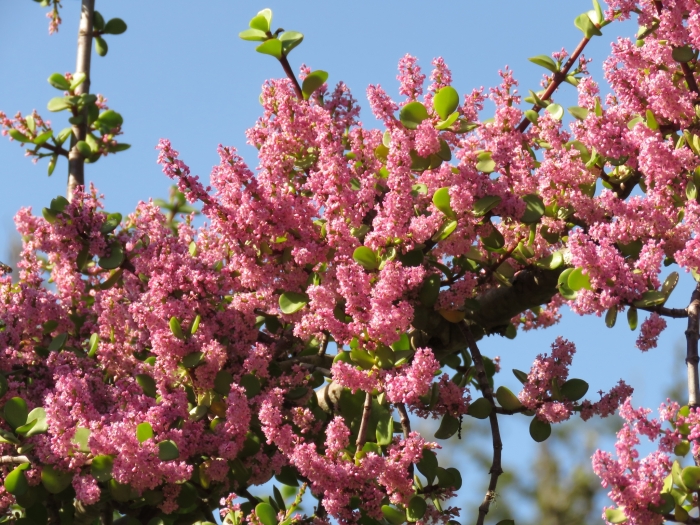Elephant Bush
(Portulacaria afra)
Elephant Bush (Portulacaria afra)
/
/

Christiaan Viljoen
CC BY 4.0
Image By:
Christiaan Viljoen
Recorded By:
Copyright:
CC BY 4.0
Copyright Notice:
Photo by: Christiaan Viljoen | License Type: CC BY 4.0 | License URL: http://creativecommons.org/licenses/by/4.0/ | Rights Holder: Christiaan Viljoen | Publisher: iNaturalist | Date Created: 2019-10-11T09:04:13-07:00 |







































































Estimated Native Range
Summary
Portulacaria afra, commonly known as Elephant Bush, is a semi-deciduous succulent shrub native to rocky outcrops and dry river valleys in South Africa. It is not typically found in forests but rather in more arid environments. This plant can grow up to 8-15 feet (2.4-4.5 meters) in height and has a sprawling habit that makes it suitable for ground cover. Elephant Bush has small, rounded, fleshy leaves that are a vibrant green, often with red stems, contributing to its ornamental appeal. The variegated cultivar ’Variegata’ features leaves with creamy edges and is particularly popular among gardeners. Elephant Bush blooms with small, star-shaped pink to purple flowers in late winter to spring, although flowering is rare in cultivation.
Elephant Bush is valued for its drought tolerance and is often used in xeriscaping, rock gardens, and as a bonsai specimen. It’s an excellent choice for sunny indoor spaces or outdoor landscaping in frost-free regions. It thrives in full sun to part shade, requiring very low to low water once established, and prefers well-draining soil. While it is easy to propagate from cuttings, which root readily in most potting media, it is sensitive to overwatering which can lead to root rot. In regions where it is hardy (USDA zones 9-11), it can become invasive if not managed properly.CC BY-SA 4.0
Elephant Bush is valued for its drought tolerance and is often used in xeriscaping, rock gardens, and as a bonsai specimen. It’s an excellent choice for sunny indoor spaces or outdoor landscaping in frost-free regions. It thrives in full sun to part shade, requiring very low to low water once established, and prefers well-draining soil. While it is easy to propagate from cuttings, which root readily in most potting media, it is sensitive to overwatering which can lead to root rot. In regions where it is hardy (USDA zones 9-11), it can become invasive if not managed properly.CC BY-SA 4.0
Plant Description
- Plant Type: Succulent
- Height: 3-12 feet
- Width: 2-5 feet
- Growth Rate: Moderate
- Flower Color: Pink
- Flowering Season: Spring, Summer
- Leaf Retention: Semi-Deciduous
Growth Requirements
- Sun: Full Sun, Part Shade
- Water: Very Low, Low
- Drainage: Fast
Common Uses
Bee Garden, Bird Garden, Butterfly Garden, Drought Tolerant, Erosion Control, Fire Resistant, Groundcover, Low Maintenance, Showy Flowers, Street Planting
Natural Habitat
Rocky outcrops and dry river valleys in South Africa
Other Names
Common Names: Elephant-Bush, Dwarf Jade Plant, Porkbush, Purslane Tree, Speckboom, Speckbaum, Pourpier En Arbre
Scientific Names: , Portulacaria afra, Portulacaria afra f. variegata, Crassula portulacaria, Portulaca afra, Crassula arborea, Claytonia portulacaria, Haenkea crassifolia, Portulaca fruticosa, Portulacaria afra f. macrophylla
GBIF Accepted Name: Portulacaria afra Jacq.